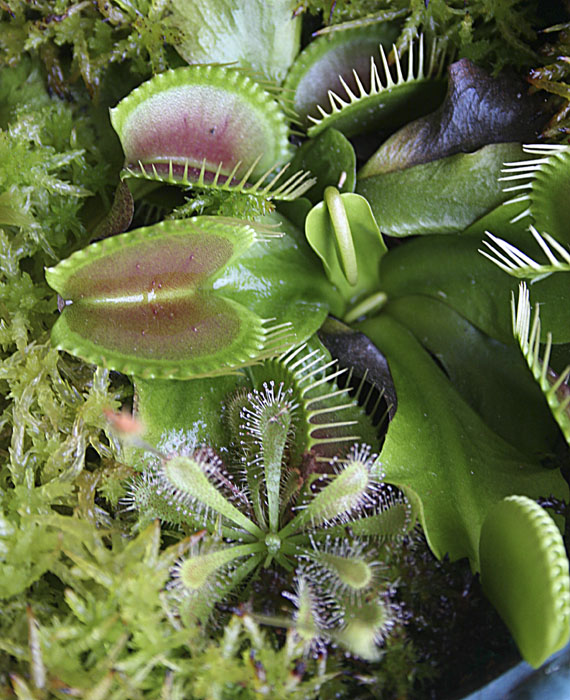Welcome!

To
Mike's Carnivorous Plant Website

Venus Flytrap & Sundew
Despite what you have seen in the movies,
there are no man-eating plants. There are however, plants that grow in nitrogen
poor soil that have evolved the ability to trap insects and small animals with
methods that would put science fiction to shame. This website is dedicated to
these wonderful plants.
To capture their prey, the plants have
developed three different trap styles. The most familiar is the active
trap, typified by the fast acting leafy jaws of the Venus Flytrap. Insects are attracted to the traps by a sweet nectar inside. Three trigger hairs inside the trap
sense when a insect is present. If one hair is
touched, nothing happens. If however, the hair is touched again, or one of the
other two is touched, then the trap springs closed. Further struggling causes
the trap to seal tighter. The trap then fills with a digestive enzyme, which
breaks down the soft parts of the insect so that it can be absorbed by the
plant. The process can take several days. When the insect is completely
digested, the trap reopens, in wait of another victim.
The semi-active trap uses
sticky fluid as itís main means of capture. Sundews
and Butterworts both fall into this category. Once
the insect is stuck to the adhesive, the plant begins a slow movement to bring more sticky adhesive in contact with it. Sundews do this by
bending their sticky tentacles, and Butterworts do it
by rolling up their leaves to cup the digestive fluid. Once firmly captured,
the plants then secrete a digestive enzyme to dissolve the soft parts of the
insect. With sundews, the insect can be ingested in a matter of hours.
Passive traps
like Pitcher Plants, the Cobra Lily, and the Nepenthes, capture insects without
movement. Sweet nectar at the entrance to the trap attracts the insect. In the
Pitcher Plant, downward pointing hairs allow the insect to move further in, but
not back. The insect finally gets to an area that is as slick as glass, and it
loses itís footing. It falls into a pool of digestive
fluid where it drowns and becomes a meal for the plant.
Carnivorous Plants generally like acid
soil or sphagnum moss and high humidity. They do well in terrariums.
All images and pictures on this website
are (c)2019 by Michael F. Borman

To
Mike's Carnivorous Plant Website
|
|
Venus Flytrap & Sundew
Despite what you have seen in the movies,
there are no man-eating plants. There are however, plants that grow in nitrogen
poor soil that have evolved the ability to trap insects and small animals with
methods that would put science fiction to shame. This website is dedicated to
these wonderful plants.
To capture their prey, the plants have
developed three different trap styles. The most familiar is the active
trap, typified by the fast acting leafy jaws of the Venus Flytrap. Insects are attracted to the traps by a sweet nectar inside. Three trigger hairs inside the trap
sense when a insect is present. If one hair is
touched, nothing happens. If however, the hair is touched again, or one of the
other two is touched, then the trap springs closed. Further struggling causes
the trap to seal tighter. The trap then fills with a digestive enzyme, which
breaks down the soft parts of the insect so that it can be absorbed by the
plant. The process can take several days. When the insect is completely
digested, the trap reopens, in wait of another victim.
The semi-active trap uses
sticky fluid as itís main means of capture. Sundews
and Butterworts both fall into this category. Once
the insect is stuck to the adhesive, the plant begins a slow movement to bring more sticky adhesive in contact with it. Sundews do this by
bending their sticky tentacles, and Butterworts do it
by rolling up their leaves to cup the digestive fluid. Once firmly captured,
the plants then secrete a digestive enzyme to dissolve the soft parts of the
insect. With sundews, the insect can be ingested in a matter of hours.
Passive traps
like Pitcher Plants, the Cobra Lily, and the Nepenthes, capture insects without
movement. Sweet nectar at the entrance to the trap attracts the insect. In the
Pitcher Plant, downward pointing hairs allow the insect to move further in, but
not back. The insect finally gets to an area that is as slick as glass, and it
loses itís footing. It falls into a pool of digestive
fluid where it drowns and becomes a meal for the plant.
Carnivorous Plants generally like acid
soil or sphagnum moss and high humidity. They do well in terrariums.
All images and pictures on this website
are (c)2019 by Michael F. Borman